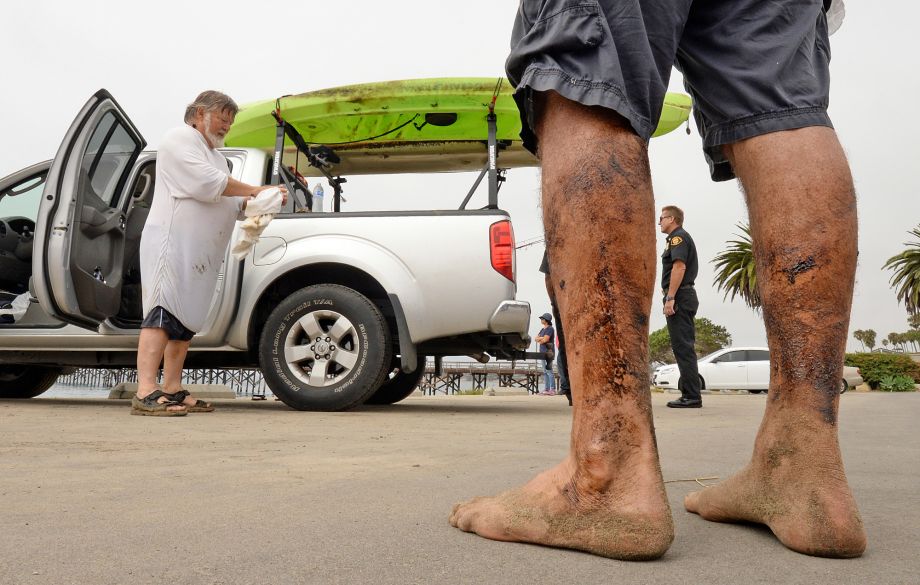Scientist: Oil slick likely from natural seafloor seepage
Updated 8:12 pm, Thursday, July 30, 2015

In this photo provided by the Santa Barbara County, Calif., Fire Department, Henry Duncan, left, and Bob Seiler, legs covered in oil, foreground, stand in the Goleta Beach parking lot with their oil-covered kayaks, on the truck at rear, in Goleta, Calif., Wednesday, July 29, 2015. The pair encountered a large oil sheen and called the fire department to investigate. The Coast Guard is investigating this new oil slick off the Southern California coast about a dozen miles from where a broken pipeline spilled thousands of gallons of crude into the ocean in May. (Mike Eliason/ Santa Barbara County Fire Department via AP)
LOS ANGELES (AP) — Coast Guard officials say it will likely be a couple more days before they can definitively say what caused a miles-long oil slick to materialize off the Santa Barbara County coast this week, but an expert said Thursday it was more than likely the result of ocean-floor seepage.
Beaches all along the coast remained open and crowded Thursday, with health officials saying the 3-mile sheen is harmless to people. That's in contrast to the mass closure that occurred in the same area in May when a broken pipeline spilled 100,000 gallons of crude oil, fouling sands, seabirds and fishing areas for miles.
Coast Guard Petty Officer Andrea Anderson said samples of the spill were collected Wednesday and Thursday and were being sent to a lab for analysis.
"They expect to hear back about the results in a couple days," she said Thursday.
The oil is floating in the Santa Barbara Channel above the Coal Oil Point seep field, a region known for releasing methane and also about 100 barrels of liquid petroleum per day, said Jordan Clark, professor of earth science and environmental studies at University of California, Santa Barbara.
It's not uncommon for even larger amounts of oil to occasionally be "burped" from the sea floor, he said, noting that Spanish explorers first documented the natural seepage centuries ago. It's one of the largest seep fields in the world, he said.
"If you fly in to Santa Barbara airport you can often see slicks on the water out there. It's reasonable for a slick this size to be spotted in the seepage area" of Coal Oil Point, Clark said. He called the size of the sheen "relatively insignificant" and agreed with Coast Guard officials who predicted it would likely dissipate in a day or two.
The slick was first observed Wednesday morning after firefighters went to the Goleta pier to check on reports of a smell of gas. They found two kayakers who had just come ashore with their legs and boats covered in oil. One of them, Bob Seiler, told KABC-TV that he and a friend were fishing when they suddenly found themselves enveloped by the oil.
"We were heading to the end of the kelp bed that's out there and the further we got out there the thicker this film was," he said.
Although the slick was large, it wasn't thick and gooey enough to be scooped up, Coast Guard Petty Officer Sondra-Kay Kneen said. It should simply break up and deplete on its own in the days ahead, she said.
The Santa Barbara County Department of Public Health said the slick provided no threat to public health and safety, although officials advised people to avoid contact with the oil.
The sheen was floating not far from the channel's Platform Holly oil facility Wednesday, but officials with Venoco Inc., which operates the platform, said it could not have come from there.
Zach Shulman, the company's director for corporate finance and investor relations, said the platform has been shut down since May.
"We do operate a pipeline that runs along the seafloor that connects the platform to an onshore facility," he said in an email. "That pipeline was previously evacuated of oil, and is currently filled with sea water."
Clark said ocean-floor seepage generally increases when the platform is not active.
The sheen was located about 12 miles away from the site where an onshore pipeline operated by Texas-based Plains All American ruptured at Refugio State Beach in May. The break flooded the area with 100,000 gallons of crude, of which 21,000 gallons ended up in the ocean.
Cleanup of that spill has been pegged at nearly $100 million.
___
Associated Press writer Linda Zhang contributed to this story.